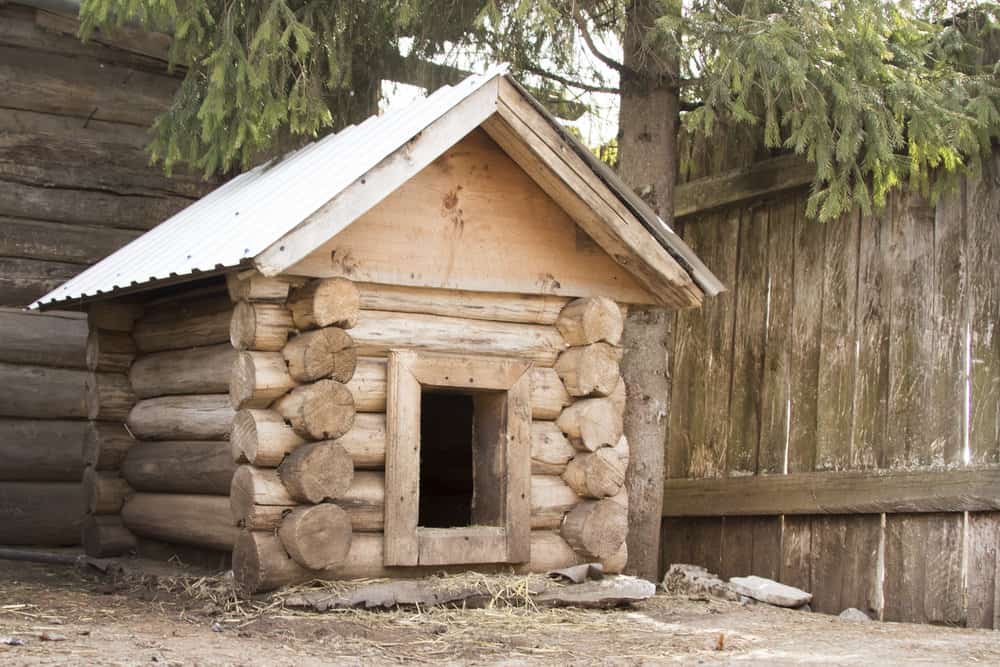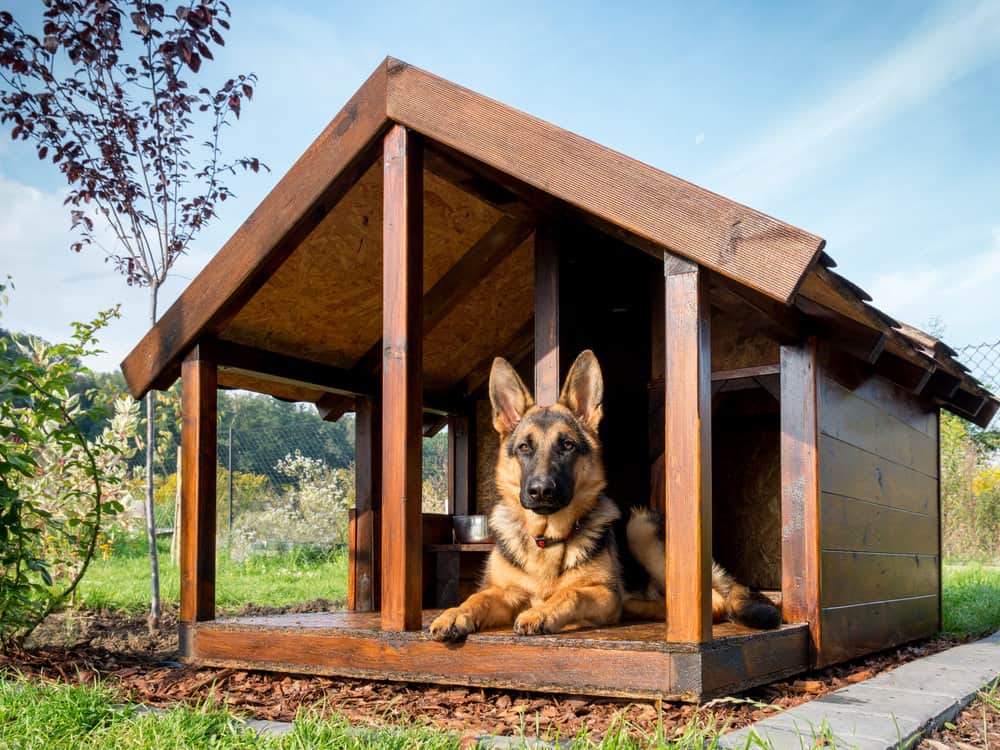While the answer varies depending on factors such as breed and temperament, you can’t go wrong with waiting until the puppy turns one. Most puppies mature into fully grown dogs at one year of age.
Still, you can’t keep them indoors throughout the whole first year, and this is where things get a little tricky.
As a responsible dog parent, one of your duties is to ensure that your pup grows up in a safe environment while also experiencing the world as positively as possible.
This way, when it’s time to start living outside, your pup is ready.
Why Can’t a Puppy Under One Live Outside?
The first few months of your puppy's life are critical for his development and bonding with you as well as the rest of the family.
Still, there are two major reasons why puppies under one year old would be at risk if left outside:
Extreme Weather

Regardless of breed, puppies can’t regulate their body temperature in the same way that adult dogs do. So, they can’t tolerate hot, humid or cold, snowy climates.
That’s why you should keep the little guy indoors whenever the weather starts acting up. Temperatures any higher than 90°F and any lower than 32°F are what you need to watch out for.
During extremely hot or cold weather, outings can’t exceed 15 minutes for smaller breeds. For larger breeds, they can stay outside from 30 minutes to an hour.
Helpful Dog Training Resource:
For help with training your dog, you should take a look at The Online Dog Trainer by Doggy Dan. Doggy Dan is an expert Dog Trainer based in New Zealand. His online resource contains Hundreds of Excellent Dog Training Videos that will take you step-by-step through the process of developing a healthy, happy well-behaved dog.
Infections and Diseases
Allowing your puppy outside, even for a few minutes, can expose him to a variety of disease-carrying insects and other animals that may carry bacteria, viruses, and parasites.
Because their immune systems are still developing, puppies are especially vulnerable to those infections and diseases.
As a result, your puppy will need three rounds of vaccination to be fully protected against any infections and diseases.
Your puppy will typically receive his core vaccines at the 6th, 12th, and 16th week since birth.
After your puppy has completed his vaccinations, he can begin the transition from inside to outside living.
How to Prepare My Puppy for Outside Living?
A sudden transition from living indoors to outdoors won’t be a fun experience for your pup. In fact, it can be traumatic for him.
That’s why, during the first 12 months of your puppy's life, your puppy should go through a gradual process to ensure a smooth transition.
- Expose to the Outside World
Once your little furball can move around and explore a little, it’s time to gradually introduce him to the outside world. Start with a few minutes and work your way up to a few hours a day.
Before 16 weeks, your puppy should only go to places where he won’t catch any viruses. Some places where viruses are unlikely to thrive include:
- Paved walkways
- Beaches
You can also go on bike rides if your puppy is small enough to fit in the basket.
If none of these locations is available, ensure that your puppy is nowhere near the ground when outside the house. You can even get a dog sling carrier once he’s over a couple of months old.
What’s more, no matter how many times admirers request to pat your puppy, you need to politely turn them down.
Even if infections mainly spread through other dogs, you never know if strangers have come into contact with any.
- Find a Safe Spot
Once your puppy has received his vaccinations, it’s time to begin the transition from indoor to outdoor living.
After a little exercise, to find familiarity and comfort in his surroundings, your puppy will most likely choose a spot in the garden or backyard to rest.
Your task is to have your puppy slowly grow comfortable with that spot. So, grab a seat and sit next to him while he naps.
You should do this for a week before moving on to the evenings, an hour or two before bedtime. At first, you can try to leave the chair and head inside.
If your puppy stays asleep, he’s one step closer to completing the transition. If not, that's fine. Repeat this process until your puppy no longer follows you inside and prefers to sleep outside.
Some breeds take longer than others during the transition, so don’t push the little fellow too hard. Because dogs are creatures of habit, he'll eventually get used to sleeping in his safe spot overnight.
- Get a Dog Shelter

Once the two of you have agreed on a safe spot, your next step is to provide your pup with a proper shelter.
When your puppy is ready to live outside, he’ll need a shelter to accommodate him. The best type of shelter to get for your pup should:
- Protect against both high and low temperatures
- Block wind, rain, hail, and sleet
- Prevent humidity
- Be spacious enough to allow the dog to move freely but not so large that it doesn’t stay warm in cold weather
After you place the shelter in your yard, you should put your puppy’s favorite chew toy and a familiar blanket in the doghouse.
Let him watch you throughout the process so that he associates his new home with familiarity and comfort.
Remember to keep food and water bowls nearby in case your dog wakes up hungry or thirsty in the middle of the night.
- Develop Social Skills
Dogs are social animals who need interaction with other animals or people. That’s why it’s only right to leave them outside to watch livestock, play with other dogs, or interact with people.
However, for your puppy to develop socially, you need to invest in his social life until the time comes to transition to living outside.
Your puppy needs to get plenty of bonding time, not just with you but with as many people and animals as possible.
Otherwise, you risk your pup growing up to be anxious and aggressive, especially toward unfamiliar people and animals.
That’s why you should introduce him to all kinds of sounds, smells, places, people, and animals while keeping him protected. You have to do this very gradually so that your puppy isn’t overstimulated.
Once you notice signs of overstimulation, such as constant nipping and pacing, you need to:
- Bring him to a quiet, stimuli-free area
- Talk to him in a low, calm voice
- Try to get him to sleep
You can also try introducing your puppy to a friend’s or neighbor’s dog if you don’t already have another dog.
Just keep an eye on your pup while he's playing. Not all dogs will naturally enjoy each other's company.
Helpful Dog Health Resource:
Note: Our Health is #1 Priority. It should be no different for your dog. But you need to help him. The Ultimate Guide to Dog Health is the answer. This handy guide will help you recognize the symptoms of the health problems above. Get the knowledge to stay ahead of these terrible issues that can rob your lovely dog from vigor and life. Help your friend make it to 14 yrs+ without pain and suffering.
Best Dog Breeds for Outside Living
You should keep in mind that some dog breeds, such as guard dogs and herd dogs, prefer to stay outside by nature.

So, after they grow older and bigger, they may find it easier to transition to living outside. Examples of such breeds include:
- American Foxhounds
- Alaskan Malamute
- Australian Cattle Dog
- Beagle
- Bernese Mountain Dog
- Collie
- German Shepherd
- Irish Wolfhound
- Rottweiler
- Siberian Husky
These dog breeds are used to living outside due to their natural habitat.
However, if, for example, you have an Alaskan Malamute who is used to staying indoors during cold spells, he’ll become accustomed to the heat.
So, thrusting him back outside can shock his body. Not to mention the emotional pain he’ll feel.
This is why, once your puppy has made the full transition to living outside, you must maintain consistency.

Paul has been creating content for the dog niche for many years. The information he shares comes his first hand experience growing up in dog lovers household and then owning multiple dog breeds of his own as an adult. Paul enjoys doing the hard research to collect, analyze and present our dogtemperament.com readers with the best answers to their questions.